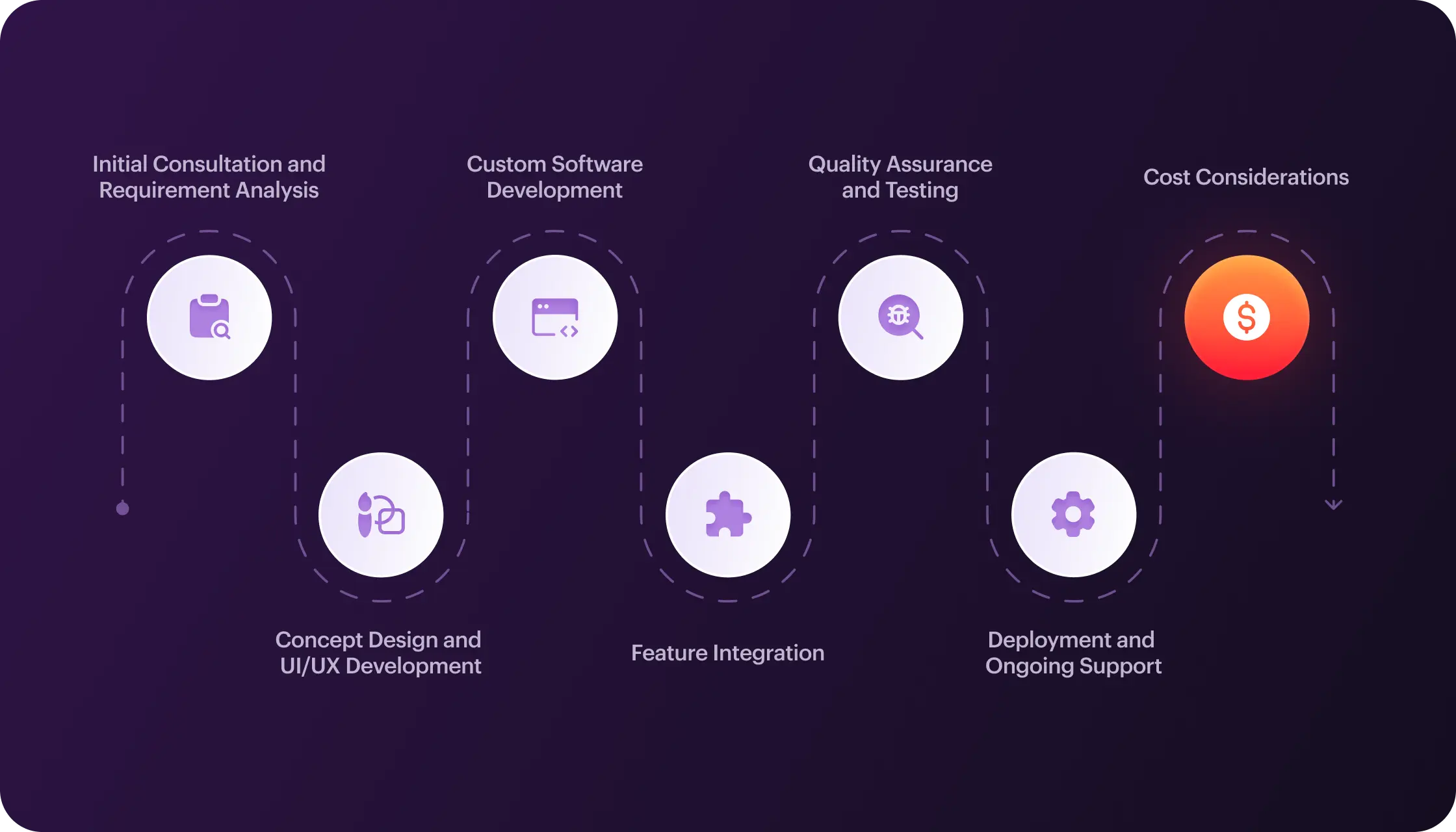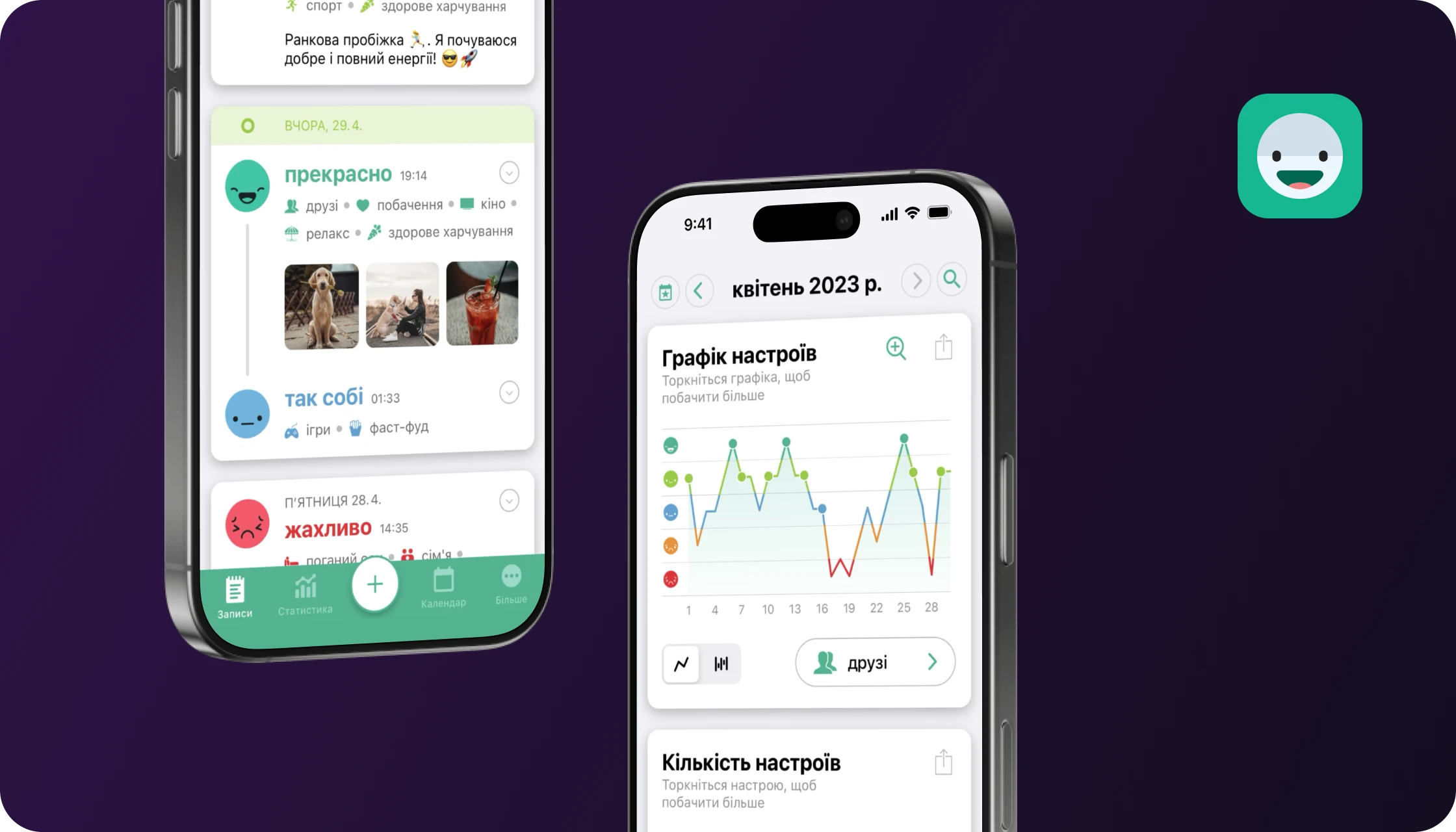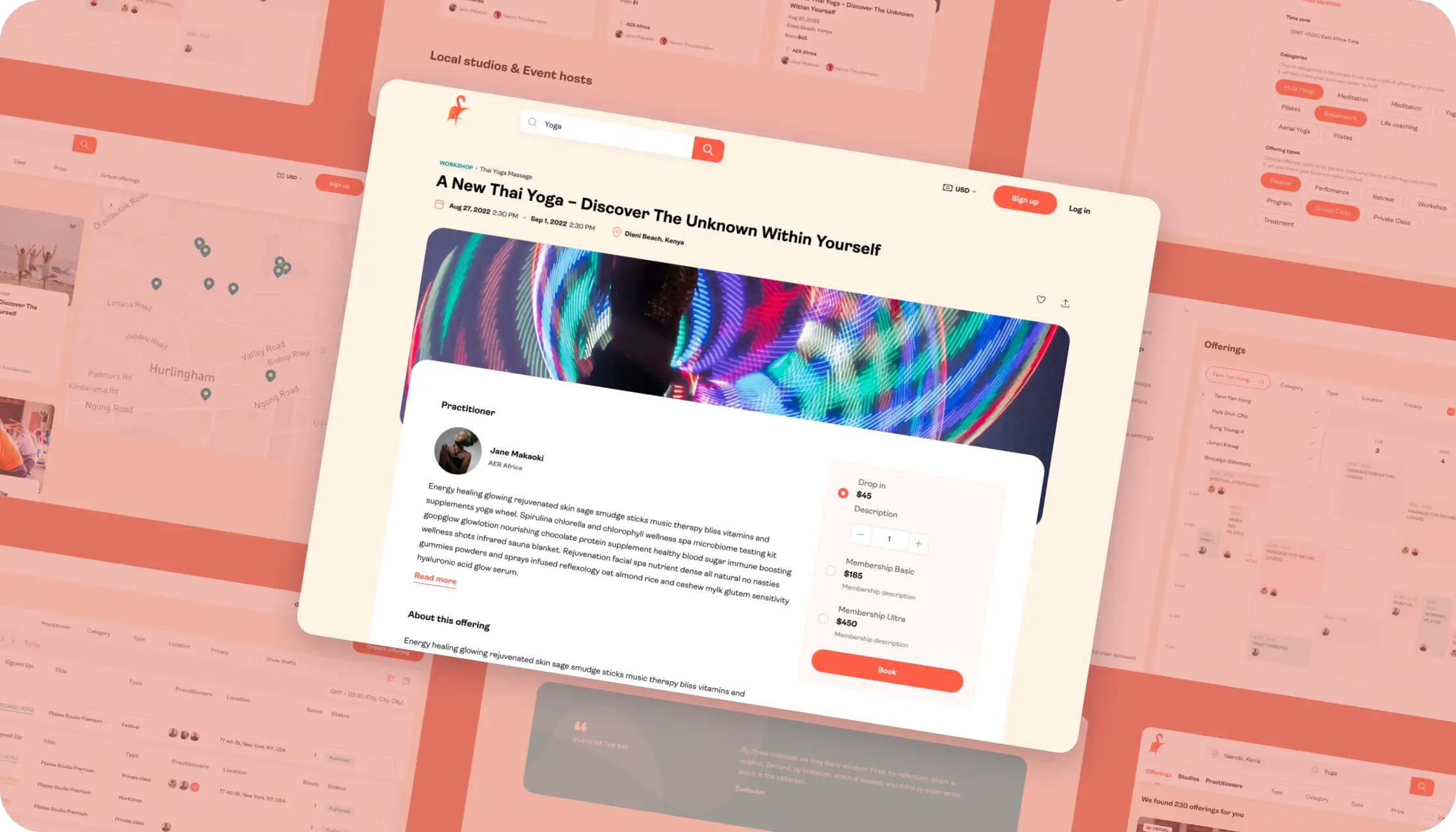Fitness Tracker App Development: Features, Costs, and Best Practices

Since 41% of Americans own wearable devices (smartwatches or fitness trackers), fitness isn't just a lifestyle—it's a trillion-dollar digital gold rush. From tracking 10,000 steps to crushing personalized HIIT workouts, fitness apps are the new personal trainers.
In this article, we will explore the meaning of a fitness tracker app, its key features, market overview, trends, deployment steps, and monetization tips.
Fitness Software Development Overview
The fitness app market reached $9.25 billion in 2023 alone. COVID-19 forced a shift from gyms to virtual training, and the numbers prove it: downloads soared, and daily active users hit new highs.
The fitness apps market is surging at 14.08% annually, reshaping how people stay active. Moreover, with 94% of Gen Z on board with the rise of gadget usage, ready to embrace fitness apps as their go-to wellness tool, the market growth won't stop here. By 2029, it's projected to add size at 13.2%, and the market is set to hit $10.06B.
It seems there's no turning back for digital fitness.

Understanding Fitness Tracker Apps
To understand what a fitness tracker app is, think of it as a personal digital assistant that logs physical activities and health metrics.
Fitness tracker apps use built-in or connected devices' sensors—such as accelerometers, gyroscopes, GPS, and heart rate monitors—to collect real-time data on movement, physiological changes, and sleep cycles.
If we look at how fitness tracker apps work, we will see that they visualize progress through graphs and charts—many sync with smartwatches or fitness bands to improve tracking accuracy.
Categories of Fitness Apps
Though by definition, it is clear that fitness apps monitor fitness data, they cover and support many other functions. Among them are wellness, nutrition, and mental well-being. Below, we'll break down six main categories.
Activity Tracking Apps
Activity tracking apps count each step taken. They are often paired with smartwatches or fitness bands to offer detailed activity achievements. Users can monitor their progress toward daily goals, like achieving 10,000 steps, using visual graphs and statistical data. Additionally, these apps show calories burned and may include sleep pattern analysis.
Examples: Fitbit, Google Fit, Strava.
Exercise and Training Apps
Exercise and training apps deliver structured programs for strength building, cardio improvement, and weight loss. They include video demonstrations and detailed instructions while tracking progress. Some apps extend their focus to running, cycling, and personalized nutrition plans.
Examples: Nike Training Club, MyFitnessPal.
Meal Planning and Nutrition Apps
Nutrition apps record calorie consumption and macronutrient breakdown. They include food logging, barcode scanning, and personalized meal plans. Users set clear dietary goals, whether for weight management, muscle development, or improved eating habits.
Examples: Lose It!, Yazio.
Mental Health and Mood Monitoring Apps
Mental health and mood monitoring applications help users keep track of their emotions and reduce stress. They entail mood diaries, guided meditations, breathing exercises, and CBT techniques.
Examples: Headspace, Calm.
Yoga and Meditation Apps
Yoga and meditation apps deliver structured yoga sessions and meditation guidance. They feature pose libraries and allow customized audio or video instruction sessions. Users benefit from increased flexibility, reduced stress, and clearer mental focus.
Examples: Down Dog, Insight Timer, and Asana Rebel.
Personal Coaching Apps
Personal coaching apps link users with professional coaches or trainers for customized fitness and health advice. The apps provide one-on-one support, personalized workout or nutrition plans, and scheduled accountability check-ins. This makes them suitable for people with specific objectives, like marathon training or long-term weight loss. Apps blend technology with human coaching to create a tailored experience and interactivity.
Examples: Noom, Trainerize.
Key Features of a Fitness Tracker App
A standout fitness tracker app grabs users with bold tools and electric energy. Here's what every app demands:
Activity and Step Tracking
Monitors daily motion and calorie consumption, presenting progress and history through simple visuals like graphs and charts.
Health Monitoring
Top apps track health data like heart rate and stress. They use sensors to give users accurate, ongoing updates and alerts.
Sleep Tracking and Analysis
A must-have for understanding sleep patterns—duration, quality, and stages (light, deep, REM). Top apps analyze this data to offer actionable tips for better rest, like adjusting bedtime routines.
Goal Setting and Progress Tracking
Allows users to set custom goals (e.g., 10,000 steps/day or 8 hours of sleep) and track progress over time, with visual milestones or rewards to enhance engagement.
Routes and Mapping
Uses GPS to map routes, track pace, and log elevation for outdoor enthusiasts like runners or cyclists. Plus, it allows them to review or share their paths.

Notifications
Timely reminders to move, drink water, or hit daily targets keep users on track. The app should balance usefulness with avoiding notification fatigue.
Integration with Wearable Devices
Ensures seamless syncing with smartwatches or fitness bands (e.g., Apple Watch, Fitbit), providing a unified experience across devices.
Social and Gamification Features
It adds leaderboards, challenges, and friend connections to make fitness fun and competitive, with gamification like earning badges—boosting long-term use.
Personalized Insights and AI-Based Recommendations
The AI analyzes workouts, sleep, nutrition, and progress trends to give personalized advice. For example, it might recommend a recovery day after heavy exercise or adjust goals based on well-being.
Tech Stack For Creating Fitness Apps
A strong front-end, back-end, database, APIs, and cloud hosting lay the groundwork for long-term success. Below we’ve outlined tips on the best tech stack:
Front-end
Craft a captivating user experience with the right front-end tools. Whether you're building for mobile or web, these technologies will help you create intuitive and visually stunning interfaces.
- Swift: Unlock native iOS performance and seamless integration with Apple services.
- Kotlin: Leverage robust Android development with Google's support.
- Flutter: Build cross-platform apps with a single codebase for cost-effective development.
- React Native: Rapidly develop cross-platform apps with a shared codebase.
For web apps:
- React.js/Next.js: Deliver responsive and dynamic web experiences.
- Vue.js: Enjoy a lightweight alternative with a more straightforward learning curve.
Back-end
A robust back-end powers your app's core functions. From data storage to real-time interactions, these technologies ensure your app runs smoothly and efficiently.
- Node.js & Express.js: Perfect for real-time interactions like chat support and live sessions.
- Django: Supports AI-driven recommendations for personalized insights.
- Firebase: Cost-effective and ideal for startups, offering real-time data sync.
- AWS Lambda: Go serverless to reduce maintenance costs.
Database
Choose the right database to store and manage user data effectively. Whether you need structured data or flexibility, these options have covered you.
- PostgreSQL: Ideal for structured data like exercise logs and progress reports.
- MongoDB: Flexible for apps with user-generated content.
- Google Firestore: Real-time syncing for social and community features.
- TimescaleDB: Optimized for analyzing long-term fitness trends.
APIs and Integrations
Integrate third-party services seamlessly with APIs. Enhance your app's functionality without extensive development.
- HealthKit & Google Fit: Track fitness metrics like workouts and heart rate.
- Strava API: Monitor running, cycling, and community challenges.
- TensorFlow/OpenAI API: Unlock AI-driven insights for personalized workouts.
- Google Speech-to-Text API: Enable voice logging for workouts and reminders.
Payment Gateways
Secure transactions are crucial for subscriptions and in-app purchases. These gateways protect financial information and ensure smooth processing.
- Stripe, PayPal, Apple Pay, Google Pay: Secure and reliable payment options.
Push Notifications
Keep users engaged with timely reminders, updates, and challenges. Push notifications boost interaction and retention.
- Firebase Cloud Messaging (FCM): Send real-time notifications.
- OneSignal: Personalize notifications based on user activity.
Cloud and Hosting
Ensure your app scales efficiently with the right cloud hosting. From secure infrastructure to cost-effective solutions, these options support growing applications.
- AWS: Secure and scalable cloud hosting.
- Google Cloud Platform (GCP): Integrates analytics and AI capabilities.
- Firebase Hosting: Fast deployment for small apps.
- DigitalOcean: Cost-effective for early-stage apps.
Fitness Tracker App Development Process
Behind every great fitness tracking app is a rock-solid plan—here’s how to craft one that dominates the market.
Market Research and Target Audience Analysis
This initial phase will lay the groundwork for understanding how to develop a fitness app effectively. Explore the fitness tech industry, research competitors, and identify user habits to shape a product that resonates. Whether targeting everyday gym-goers or elite athletes, ensure the app meets real needs yet is unique.
Pro Tips: Use Google Trends and Statista for keyword insights, survey 200+ users with a 60/40 quantitative-qualitative split, and analyze at least 5 top competitor apps (e.g., Fitbit, Strava) on app stores, focusing on user reviews with 3-star ratings to spot unmet needs.
Defining Core Functionalities
Once research findings are clear, define core features like step tracking, calorie counting, and wearable integration while adding unique elements—personalized workouts or gamified challenges—to solve real user problems without clutter.
Pro Tips: Keep core features between 5 and 7. Focus 70% of fitness application development on essentials like accurate step tracking, and test early with 20-30 beta users.
Choosing the Right Technology Stack
Tech stack can make or break your app. Go native with Swift (iOS) or Kotlin (Android) for top-tier performance, or use Flutter or React Native for a cross-platform edge. Power the backend with Firebase for simplicity or AWS for enterprise muscle. Ensure seamless integration with Apple Health, Google Fit, and future expansions.
Pro Tips: Optimize for 80% of wearable users via Apple & Fitbit APIs, slash dev time by 40% using Flutter, and benchmark response times under 200ms for real-time accuracy.
UI/UX Design for an Engaging User Experience
Turn concepts into a sleek, intuitive app with fluid navigation, bold visuals, and a dashboard that highlights key fitness metrics. Additionally, fine-tune details with real user feedback for a flawless experience.
Pro Tips: Use a 60-30-10 color rule for balance, ensure 48x48px tap targets for accessibility, and run usability tests with 5-8 users to catch issues.
Development and Testing Phase
Here, development takes center stage. Engineers implement features, integrate APIs, and fine-tune performance while testers identify and resolve issues rigorously. The goal is a stable, high-performing app that remains reliable under real-world stressors like network fluctuations and peak traffic.
Pro Tips: Ensure crash-free sessions with Crashlytics, test on 10+ devices covering 90% of users.
Launch and Post-Launch Support
It’s release time! Publish on the Apple App Store and Google Play, track feedback, and squash bugs fast. Upgrade features and fine-tune performance to keep users engaged.
Pro Tips: Optimize App Store metadata with 3-5 high-traffic keywords, try to respond to all reviews within 24 hours for the first month, and schedule updates every 6-8 weeks based on usage data to maximize engagement.

Average Cost of Fitness App Development
A fitness app’s price tag correlates with its technical ambition. Entry-level builds (3–6 months) focus on MVP essentials—profile setup, exercise demos, goal tracking, and email/SMS alerts—costing $38K–50K. Mid-range projects (6–9 months) embed dynamic plans, device interoperability, leaderboards, and microtransactions, averaging $50K–75K.
High-complexity apps (9+ months) deploy AI posture correction, telehealth integrations, and enterprise dashboards, starting at $75K and rising. Freelancers may undercut agencies but risk fragmented deliverables. Invest in a vetted team with full-cycle development experience for scalable architecture and compliance.

How to Monetize a Fitness App
Revenue growth in fitness tracking app development is supported by:
- Paid Apps.
Charge users an upfront fee to download and access the app. Pricing depends on the app’s features, content, and platform.
- In-App Purchases.
Sell additional content such as workout plans, meal recipes, or motivational music to enhance the user experience.
- Premium Subscriptions (Freemium Model).
Offer a free version with basic features while reserving advanced fitness plans, personal coaching, and exclusive content for paying subscribers.
- Advertisements.
Display relevant ads without disrupting user experience. Fitness-related promotions work best to maintain engagement.
- Sponsored Content.
Partner with gyms, trainers, or fitness brands to distribute their content within the app in exchange for payment.
- eCommerce Integration.
Sell branded fitness gear, accessories, or custom fitness trackers through the app or an external store.
Most Popular Fitness Tracker Apps 2025
Explore the top fitness apps, their standout features, and key takeaways from their success.
MyFitnessPal
MyFitnessPal is more than a calorie counter—it’s a complete nutrition and fitness tracking tool. AI-driven meal analysis scans food photos for accurate macros, while seamless wearable integration adjusts calorie goals based on recovery data.
Best For: Users who want precise food tracking and adaptive nutrition guidance.
Nike Training Club (NTC)
NTC delivers personalized workouts that adapt mid-session based on heart rate. "Smart Form Check" analyzes posture in real time, while AR integration brings guided workouts into any space.
Best For: Users seeking smart, adaptive training with real-time feedback.
Strava
Strava is the top choice for runners and cyclists, offering in-depth performance insights. New features track how terrain affects effort and monitor gear wear to prevent injuries.
Best For: Outdoor athletes looking for advanced performance tracking.
Fitbod
Fitbod creates strength-training plans based on fatigue and progress. It predicts recovery needs, suggests optimal weight increases, and highlights neglected muscle groups with 3D mapping.
Best For: Strength trainers wanting a data-driven, adaptive workout plan.
Headspace
Headspace connects mindfulness with fitness. It tracks stress, recommends pre-workout meditation, and logs post-exercise reflections to improve focus and recovery.
Best For: Athletes prioritizing mental resilience and recovery.
Challenges in Fitness Tracker App Development
Fitness tracker apps have revolutionized health monitoring, but their development is fraught with challenges. Four key hurdles stand out:
Ensuring Accuracy of Health Data
Accuracy of the health data is the backbone of any fitness tracking app. Users depend on metrics like step counts, heart rate, and calorie burn to make informed health decisions. Inaccurate data can mislead users, erode trust, or even pose health risks. Poor sensor quality, flawed algorithms, and inconsistent user input contribute to this challenge.
Solutions:
- High-Quality Sensors and Algorithms: Developers should use reliable sensors and collaborate with health experts to design precise algorithms. These algorithms must be validated against benchmarks to ensure metrics align with real-world outcomes.
- User Input Optimization: Create intuitive interfaces that encourage users to input accurate details (e.g., age, weight) and include calibration features to account for variables like terrain or weather.
- Continuous Refinement: Regularly update algorithms based on user feedback and emerging research to maintain accuracy over time.
User Privacy and Data Security Compliance
Health data is highly sensitive, and users expect it to be protected. Developers must comply with strict regulations like GDPR (General Data Protection Regulation) and HIPAA (Health Insurance Portability and Accountability Act) while safeguarding against cybersecurity threats. A breach can damage user trust and result in legal consequences.
Solutions:
- Robust Encryption: Implement strong encryption for data both in transit (e.g., during syncing) and at rest (e.g., in storage) to prevent unauthorized access.
- Regulatory Compliance: Secure explicit user consent for data collection and anonymize data used for research or analytics to meet legal standards.
- Proactive Security: Use two-factor authentication and conduct regular security audits to stay ahead of evolving threats.
Device Compatibility and Integration Issues
Fitness tracking apps must function seamlessly across various devices, operating systems (e.g., iOS, Android), and third-party platforms (e.g., Apple Health, Google Fit). Variability in hardware, differing OS APIs, and high battery consumption complicate this process, potentially leading to inconsistent user experiences.
Solutions:
- Cross-Platform Development: Use modular designs and frameworks (e.g., Flutter, React Native) to adapt to hardware differences and ensure compatibility across operating systems.
- Third-Party Integration: Follow platform-specific protocols to integrate smoothly with external services, enabling data syncing without disrupting functionality.
- Battery Optimization: Minimize resource usage by optimizing code and reducing background processes to prevent excessive battery drain.
Keeping Users Engaged Long-Term
Since the market has its established leaders, it is tough to compete, surprise, and engage users. Many abandon apps due to a lack of motivation or repetitive experiences. Developers must find ways to unify their product to stay relevant over time.
Solutions:
- Personalization: Tailor fitness plans and recommendations to individual user goals (e.g., weight loss, endurance) and preferences, enhancing relevance.
- Gamification: Introduce rewards, challenges, or badges to make fitness fun and encourage consistent use.
- Community and Feedback: Build social features (e.g., leaderboards, group challenges) and provide actionable progress reports to foster a sense of connection and achievement.
Future Trends in Fitness Tracker Apps
The fitness app race is heating up. According to a fitness app market analysis by Grand View Research, top startups are betting on mHealth (hydration, women’s health, safety) and techs like AI, VR, and wearables. Miss these trends, and you lose. Read on for a detailed overview of trends:
Mental Health & Wellness
Mental wellness is now a core focus in developing a fitness app. Sensor Tower’s 2024 data shows rising demand for stress relief and mindfulness tools. Apps include meditation, breathwork, and sleep options. At the same time, Headspace and other platforms are adding fitness routines, which results in a well-rounded approach to health.
Women in Focus
With women making up almost 60% of users, fitness apps are stepping up. Sweat features top female trainers. HARNA customizes workouts based on menstrual cycles, providing a unique fitness approach.
Smart Personalization with AI & ML
AI-driven apps now customize workouts, predict the best recovery plans, and enhance motivation. Thus, Freeletics tailors schedules, MyFitnessPal adds competition, and Future delivers real-time coaching for next-level training.
VR and AR Revolution
VR and AR revolutionize fitness by making workouts an immersive and engaging experience. Instead of staring at a screen, users can cycle through 3D landscapes (Zwift) or boxes in an interactive arena (Liteboxer VR).
Seamless Wearable Integration
Fitness apps and wearables combine and extend their functionality beyond mere exercise trackers. With Fitbit, Apple Watch, and Whoop leading the charge, biometric data, such as sleep quality, heart rate, recovery, and exertion levels, helps them meet their fitness goals.
Gamification for Engagement
Gamification keeps users motivated with points, challenges, and rewards. Strava fuels competition with leaderboards, while Nike Run Club celebrates milestones with achievement badges, making every workout a victory.
Eco-Conscious
Gen Z demands sustainability, and fitness apps are stepping up. Low-carbon workouts, green brand partnerships, and impact tracking are redefining fitness. Plogga turns runs into clean-up missions, while Ecosia Active plants trees with every workout.
Build a Fitness Tracker App with Darly Solutions
Fitness platforms are close to one of our core specializations—healthcare and wearable app development. We follow a structured process to ensure a high-quality, user-centric product that meets your business goals.
1. Initial Consultation and Requirement Analysis.
Contact Darly Solutions to discuss your app vision. Their team will assess your objectives, target audience, and desired features to align the final product with market demands.
2. Concept Design and UI/UX Development.
Darly Solutions designs intuitive, engaging interfaces that enhance user experience. Their FitSync concept demonstrates expertise in crafting user-friendly fitness applications with personalized fitness plans.
3. Custom Software Development.
As a custom software development company, Darly Solutions builds scalable fitness tracker apps using the latest technologies to ensure smooth device performance.
4. Feature Integration.
Key functionalities include activity tracking, goal setting, data visualization, and wearable device integration. These features enhance user engagement and provide valuable fitness insights.
5. Quality Assurance and Testing.
Rigorous testing ensures a reliable, bug-free application that delivers optimal performance.
6. Deployment and Ongoing Support.
After launch, Darly Solutions provides continuous updates, security enhancements, and technical support to keep the app competitive.
7. Cost Considerations.
Development costs depend on complexity, features, and timeframe. Darly Solutions offers insights into budgeting to help you make informed investment decisions.

Partnering with Darly Solutions ensures a standout fitness tracker app that drives user engagement and success in the health and wellness market. Do you want to create your own fitness app, yet don’t know where to start? Darly Solutions will assist you with the right expertise and tech stack!
FAQ
Fitness app DevOps uses Swift and Kotlin for native apps, BLE for seamless device sync, AI for real-time insights, and GPS for pinpoint tracking, bringing workouts to the next level.
A fitness tracker app development takes 6-12 months, with basic versions done in 4-6 months and feature-rich builds stretching to a year. Cross-platform development, compliance, and testing add time, but an MVP can hit the market in 3-5 months.
Check for proven experience in health and fitness app development. Verify their portfolio for similar projects and client reviews. Ensure they understand wearable integrations (like Apple Watch and Fitbit), offline mode, and battery optimization. They must also offer post-launch maintenance and update policies.
Connect with us
.webp)
We are a tech partner that delivers ingenious digital solutions, engineering and vertical services for industry leaders powered by vetted talents.


.webp)























